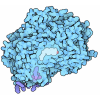+ Open data
Open data
- Basic information
Basic information
| Entry | Database: PDB / ID: 6jjy | ||||||
|---|---|---|---|---|---|---|---|
| Title | Crystal Structure of KIBRA and beta-Dystroglycan | ||||||
 Components Components |
| ||||||
 Keywords Keywords |  SIGNALING PROTEIN / WW tandem / PY tandem / SIGNALING PROTEIN / WW tandem / PY tandem /  KIBRA / KIBRA /  PTPN14 PTPN14 | ||||||
| Function / homology |  Function and homology information Function and homology informationDefective POMT2 causes MDDGA2, MDDGB2 and MDDGC2 / Defective POMT1 causes MDDGA1, MDDGB1 and MDDGC1 /  dystroglycan complex / nerve maturation / muscle attachment / Defective POMGNT1 causes MDDGA3, MDDGB3 and MDDGC3 / positive regulation of basement membrane assembly involved in embryonic body morphogenesis / retrograde trans-synaptic signaling by trans-synaptic protein complex / regulation of embryonic cell shape / regulation of hippo signaling ...Defective POMT2 causes MDDGA2, MDDGB2 and MDDGC2 / Defective POMT1 causes MDDGA1, MDDGB1 and MDDGC1 / dystroglycan complex / nerve maturation / muscle attachment / Defective POMGNT1 causes MDDGA3, MDDGB3 and MDDGC3 / positive regulation of basement membrane assembly involved in embryonic body morphogenesis / retrograde trans-synaptic signaling by trans-synaptic protein complex / regulation of embryonic cell shape / regulation of hippo signaling ...Defective POMT2 causes MDDGA2, MDDGB2 and MDDGC2 / Defective POMT1 causes MDDGA1, MDDGB1 and MDDGC1 /  dystroglycan complex / nerve maturation / muscle attachment / Defective POMGNT1 causes MDDGA3, MDDGB3 and MDDGC3 / positive regulation of basement membrane assembly involved in embryonic body morphogenesis / retrograde trans-synaptic signaling by trans-synaptic protein complex / regulation of embryonic cell shape / regulation of hippo signaling / dystroglycan complex / nerve maturation / muscle attachment / Defective POMGNT1 causes MDDGA3, MDDGB3 and MDDGC3 / positive regulation of basement membrane assembly involved in embryonic body morphogenesis / retrograde trans-synaptic signaling by trans-synaptic protein complex / regulation of embryonic cell shape / regulation of hippo signaling /  O-linked glycosylation / O-linked glycosylation /  contractile ring / Signaling by Hippo / contractile ring / Signaling by Hippo /  regulation of gastrulation / microtubule anchoring / calcium-dependent cell-matrix adhesion / morphogenesis of an epithelial sheet / regulation of gastrulation / microtubule anchoring / calcium-dependent cell-matrix adhesion / morphogenesis of an epithelial sheet /  dystrophin-associated glycoprotein complex / dystrophin-associated glycoprotein complex /  laminin-1 binding / response to denervation involved in regulation of muscle adaptation / basement membrane organization / positive regulation of myelination / laminin-1 binding / response to denervation involved in regulation of muscle adaptation / basement membrane organization / positive regulation of myelination /  regulation of epithelial to mesenchymal transition / skeletal muscle tissue regeneration / negative regulation of organ growth / photoreceptor ribbon synapse / regulation of epithelial to mesenchymal transition / skeletal muscle tissue regeneration / negative regulation of organ growth / photoreceptor ribbon synapse /  dystroglycan binding / cellular response to cholesterol / nerve development / dystroglycan binding / cellular response to cholesterol / nerve development /  vinculin binding / EGR2 and SOX10-mediated initiation of Schwann cell myelination / vinculin binding / EGR2 and SOX10-mediated initiation of Schwann cell myelination /  myelination in peripheral nervous system / branching involved in salivary gland morphogenesis / myelination in peripheral nervous system / branching involved in salivary gland morphogenesis /  node of Ranvier / node of Ranvier /  costamere / commissural neuron axon guidance / angiogenesis involved in wound healing / response to muscle activity / regulation of neurotransmitter receptor localization to postsynaptic specialization membrane / postsynaptic cytosol / axon regeneration / structural constituent of muscle / positive regulation of cell-matrix adhesion / epithelial tube branching involved in lung morphogenesis / positive regulation of oligodendrocyte differentiation / regulation of synapse organization / negative regulation of MAPK cascade / negative regulation of hippo signaling / alpha-actinin binding / plasma membrane raft / costamere / commissural neuron axon guidance / angiogenesis involved in wound healing / response to muscle activity / regulation of neurotransmitter receptor localization to postsynaptic specialization membrane / postsynaptic cytosol / axon regeneration / structural constituent of muscle / positive regulation of cell-matrix adhesion / epithelial tube branching involved in lung morphogenesis / positive regulation of oligodendrocyte differentiation / regulation of synapse organization / negative regulation of MAPK cascade / negative regulation of hippo signaling / alpha-actinin binding / plasma membrane raft /  membrane protein ectodomain proteolysis / Non-integrin membrane-ECM interactions / membrane protein ectodomain proteolysis / Non-integrin membrane-ECM interactions /  basement membrane / ECM proteoglycans / negative regulation of phosphatidylinositol 3-kinase/protein kinase B signal transduction / GABA-ergic synapse / basement membrane / ECM proteoglycans / negative regulation of phosphatidylinositol 3-kinase/protein kinase B signal transduction / GABA-ergic synapse /  laminin binding / heart morphogenesis / laminin binding / heart morphogenesis /  SH2 domain binding / SH2 domain binding /  tubulin binding / nuclear periphery / negative regulation of cell migration / tubulin binding / nuclear periphery / negative regulation of cell migration /  filopodium / filopodium /  axon guidance / morphogenesis of an epithelium / axon guidance / morphogenesis of an epithelium /  adherens junction / adherens junction /  regulation of synaptic plasticity / regulation of synaptic plasticity /  sarcolemma / response to peptide hormone / ruffle membrane / Regulation of expression of SLITs and ROBOs / sarcolemma / response to peptide hormone / ruffle membrane / Regulation of expression of SLITs and ROBOs /  kinase binding / Golgi lumen / cellular response to mechanical stimulus / kinase binding / Golgi lumen / cellular response to mechanical stimulus /  cell migration / protein-macromolecule adaptor activity / cell migration / protein-macromolecule adaptor activity /  protein transport / virus receptor activity / protein transport / virus receptor activity /  lamellipodium / lamellipodium /  actin binding / actin binding /  postsynaptic membrane / basolateral plasma membrane / collagen-containing extracellular matrix / positive regulation of MAPK cascade / postsynaptic membrane / basolateral plasma membrane / collagen-containing extracellular matrix / positive regulation of MAPK cascade /  transcription coactivator activity / molecular adaptor activity / transcription coactivator activity / molecular adaptor activity /  cytoskeleton / negative regulation of cell population proliferation / external side of plasma membrane / cytoskeleton / negative regulation of cell population proliferation / external side of plasma membrane /  endoplasmic reticulum lumen / endoplasmic reticulum lumen /  focal adhesion / intracellular membrane-bounded organelle / glutamatergic synapse / focal adhesion / intracellular membrane-bounded organelle / glutamatergic synapse /  calcium ion binding / protein-containing complex binding / regulation of DNA-templated transcription / perinuclear region of cytoplasm / negative regulation of transcription by RNA polymerase II / protein-containing complex / calcium ion binding / protein-containing complex binding / regulation of DNA-templated transcription / perinuclear region of cytoplasm / negative regulation of transcription by RNA polymerase II / protein-containing complex /  extracellular space extracellular spaceSimilarity search - Function | ||||||
| Biological species |   Mus musculus (house mouse) Mus musculus (house mouse)  Homo sapiens (human) Homo sapiens (human) | ||||||
| Method |  X-RAY DIFFRACTION / X-RAY DIFFRACTION /  SYNCHROTRON / SYNCHROTRON /  MOLECULAR REPLACEMENT / Resolution: 2.298 Å MOLECULAR REPLACEMENT / Resolution: 2.298 Å | ||||||
 Authors Authors | Lin, Z. / Yang, Z. / Ji, Z. / Zhang, M. | ||||||
 Citation Citation |  Journal: Elife / Year: 2019 Journal: Elife / Year: 2019Title: Decoding WW domain tandem-mediated target recognitions in tissue growth and cell polarity. Authors: Lin, Z. / Yang, Z. / Xie, R. / Ji, Z. / Guan, K. / Zhang, M. | ||||||
| History |
|
- Structure visualization
Structure visualization
| Structure viewer | Molecule:  Molmil Molmil Jmol/JSmol Jmol/JSmol |
|---|
- Downloads & links
Downloads & links
- Download
Download
| PDBx/mmCIF format |  6jjy.cif.gz 6jjy.cif.gz | 80.2 KB | Display |  PDBx/mmCIF format PDBx/mmCIF format |
|---|---|---|---|---|
| PDB format |  pdb6jjy.ent.gz pdb6jjy.ent.gz | 58.5 KB | Display |  PDB format PDB format |
| PDBx/mmJSON format |  6jjy.json.gz 6jjy.json.gz | Tree view |  PDBx/mmJSON format PDBx/mmJSON format | |
| Others |  Other downloads Other downloads |
-Validation report
| Arichive directory |  https://data.pdbj.org/pub/pdb/validation_reports/jj/6jjy https://data.pdbj.org/pub/pdb/validation_reports/jj/6jjy ftp://data.pdbj.org/pub/pdb/validation_reports/jj/6jjy ftp://data.pdbj.org/pub/pdb/validation_reports/jj/6jjy | HTTPS FTP |
|---|
-Related structure data
| Related structure data |  6j68SC 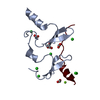 6jjwC 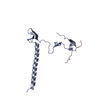 6jjxC  6jjzC 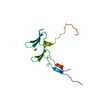 6jk0C 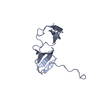 6jk1C S: Starting model for refinement C: citing same article ( |
|---|---|
| Similar structure data |
- Links
Links
- Assembly
Assembly
| Deposited unit | 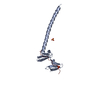
| |||||||||||||||
|---|---|---|---|---|---|---|---|---|---|---|---|---|---|---|---|---|
| 1 |
| |||||||||||||||
| Unit cell |
| |||||||||||||||
| Components on special symmetry positions |
|
- Components
Components
| #1: Protein | Mass: 16036.611 Da / Num. of mol.: 1 Source method: isolated from a genetically manipulated source Source: (gene. exp.)   Mus musculus (house mouse) / Gene: Wwc1, Kiaa0869 / Production host: Mus musculus (house mouse) / Gene: Wwc1, Kiaa0869 / Production host:   Escherichia coli (E. coli) / References: UniProt: Q5SXA9 Escherichia coli (E. coli) / References: UniProt: Q5SXA9 | ||
|---|---|---|---|
| #2: Protein/peptide |  / Dystrophin-associated glycoprotein 1 / Dystrophin-associated glycoprotein 1Mass: 2298.641 Da / Num. of mol.: 1 Source method: isolated from a genetically manipulated source Source: (gene. exp.)   Homo sapiens (human) / Gene: DAG1 / Production host: Homo sapiens (human) / Gene: DAG1 / Production host:   Escherichia coli (E. coli) / References: UniProt: Q14118 Escherichia coli (E. coli) / References: UniProt: Q14118 | ||
| #3: Chemical |  Sulfate Sulfate#4: Water | ChemComp-HOH / |  Water Water |
-Experimental details
-Experiment
| Experiment | Method:  X-RAY DIFFRACTION / Number of used crystals: 1 X-RAY DIFFRACTION / Number of used crystals: 1 |
|---|
- Sample preparation
Sample preparation
| Crystal | Density Matthews: 4.48 Å3/Da / Density % sol: 72.53 % |
|---|---|
Crystal grow | Temperature: 289 K / Method: vapor diffusion, hanging drop / pH: 6.5 / Details: 3.0-4.0M NaCl, 100mM Bis-Tris (pH 6.5) |
-Data collection
| Diffraction | Mean temperature: 100 K / Serial crystal experiment: N |
|---|---|
| Diffraction source | Source:  SYNCHROTRON / Site: SYNCHROTRON / Site:  SSRF SSRF  / Beamline: BL19U1 / Wavelength: 0.9791 Å / Beamline: BL19U1 / Wavelength: 0.9791 Å |
| Detector | Type: DECTRIS PILATUS 6M / Detector: PIXEL / Date: May 19, 2016 |
| Radiation | Protocol: SINGLE WAVELENGTH / Monochromatic (M) / Laue (L): M / Scattering type: x-ray |
| Radiation wavelength | Wavelength : 0.9791 Å / Relative weight: 1 : 0.9791 Å / Relative weight: 1 |
| Reflection | Resolution: 2.3→50 Å / Num. obs: 15114 / % possible obs: 99.7 % / Redundancy: 10.5 % / Rmerge(I) obs: 0.056 / Net I/σ(I): 40 |
| Reflection shell | Resolution: 2.3→2.34 Å / Redundancy: 10.7 % / Rmerge(I) obs: 0.886 / Mean I/σ(I) obs: 2.7 / Num. unique obs: 724 / % possible all: 100 |
- Processing
Processing
| Software |
| |||||||||||||||||||||||||||||||||||||||||||||||||||||||||||||||||||||||||||||
|---|---|---|---|---|---|---|---|---|---|---|---|---|---|---|---|---|---|---|---|---|---|---|---|---|---|---|---|---|---|---|---|---|---|---|---|---|---|---|---|---|---|---|---|---|---|---|---|---|---|---|---|---|---|---|---|---|---|---|---|---|---|---|---|---|---|---|---|---|---|---|---|---|---|---|---|---|---|---|
| Refinement | Method to determine structure : :  MOLECULAR REPLACEMENT MOLECULAR REPLACEMENTStarting model: 6J68 Resolution: 2.298→40.571 Å / SU ML: 0.29 / Cross valid method: FREE R-VALUE / σ(F): 0 / Phase error: 25.48 / Stereochemistry target values: ML
| |||||||||||||||||||||||||||||||||||||||||||||||||||||||||||||||||||||||||||||
| Solvent computation | Shrinkage radii: 0.9 Å / VDW probe radii: 1.11 Å / Solvent model: FLAT BULK SOLVENT MODEL | |||||||||||||||||||||||||||||||||||||||||||||||||||||||||||||||||||||||||||||
| Refinement step | Cycle: LAST / Resolution: 2.298→40.571 Å
| |||||||||||||||||||||||||||||||||||||||||||||||||||||||||||||||||||||||||||||
| Refine LS restraints |
| |||||||||||||||||||||||||||||||||||||||||||||||||||||||||||||||||||||||||||||
| LS refinement shell |
| |||||||||||||||||||||||||||||||||||||||||||||||||||||||||||||||||||||||||||||
| Refinement TLS params. | Method: refined / Origin x: -94.2259 Å / Origin y: 65.4788 Å / Origin z: 127.1158 Å
| |||||||||||||||||||||||||||||||||||||||||||||||||||||||||||||||||||||||||||||
| Refinement TLS group | Selection details: ALL |
 Movie
Movie Controller
Controller





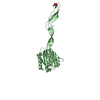
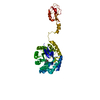


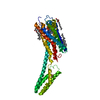
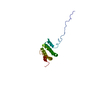
 PDBj
PDBj






